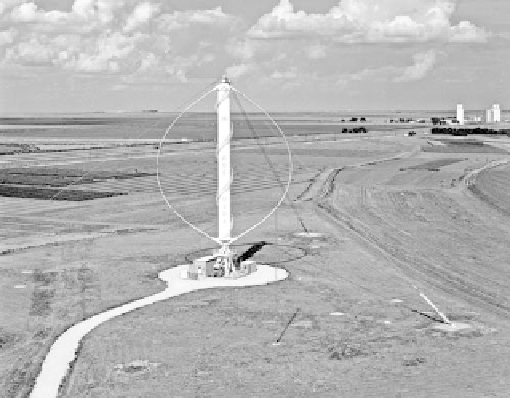Environmental Engineering Reference
In-Depth Information
FIGURE 10.10
Vertical-axis wind turbine, 34-m test bed at Research Center, USDA-ARS, Bushland, Texas,
USA. VAWT rated at 500 kW, peak power 625 kW. (Photo from USDA-ARS. With permission.)
4. Development of large wind turbines with no gearboxes.
5. Only one manufacturer of large wind turbines in the United States. Kenetech went out of
business, leaving only one manufacturer of large turbines, Zond. Zond was then purchased
by Enron and renamed Enron Wind.
The Utility Wind Integration Group in the United States published a number of brochures [48]
on all aspects of the wind industry. This information is primarily for planners in utilities and policy
makers in state governments.
10.7.3 W
IND
I
NDUSTRY
, 2000-2010
Wind turbines are now a part of the planning process for new electric plants in many countries.
Europe continues to lead in installed capacity, development of multimegawatt turbines, and manu-
facturing. Global producers of equipment for electric power plants, General Electric (Enron), United
States, and Siemens (Bonus), Germany, became manufacturers by purchasing wind turbine compa-
nies. Vestas, which absorbed NEG-Micon, is still the leading manufacturer of large wind turbines.
For large machines, the three-blade, full-span, variable-pitch, upwind machines now dominate
the market.
The most economical size of wind turbines has not been determined, as the trend has been
larger machines for the wind farm market. However, in many locations, especially islands and
other remote locations in the world, the infrastructure is the limitation for installation of mega-
watt wind turbines, for example, cranes. The larger wind turbines are now being developed for
offshore.
In the United States, with the production tax credit and the Renewable Portfolio Standard in
Texas, there was a resurgence of wind farm installations. In 2006, Texas (
Figure 10.11
) surpassed
California in installed capacity, and a number of other states have passed Renewable Portfolio
Standards. Since no wind turbines from the DOE program became major players in the commercial
market, by 2006 the research project was changed to assist manufacturers, through the program
area of the Low Speed Wind Technology Project [49]. The cost-shared research and development
projects with industry included a 2.5 MW wind turbine, Clipper Windpower; a modular power

Search WWH ::

Custom Search